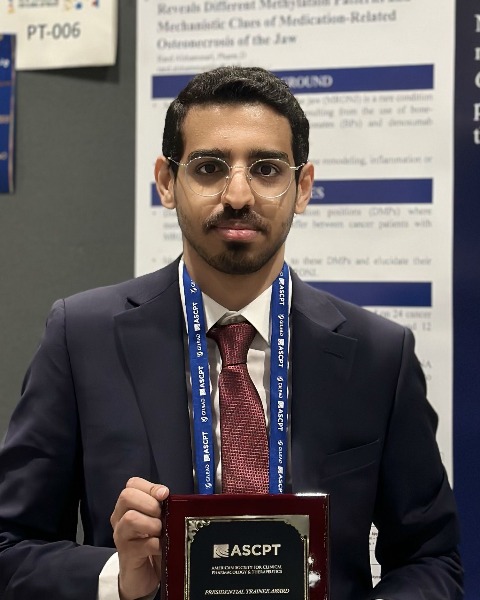Pharmacogenomics (PGx)
Category: Member Submission
Session: Poster Session II
PII-051 - METHYLATION PROFILING AND PATHWAY ENRICHMENT ANALYSIS REVEAL EPIGENETIC MECHANISMS IN CARFILZOMIB-RELATED CARDIOTOXICITY IN MULTIPLE MYELOMA PATIENTS .
Thursday, May 29, 2025
5:00 PM - 6:30 PM East Coast USA Time
R. Alshammari1,2, L. Shaffer3, E. Farber-Eger3, M. Tantawy1, Q. Wells3, Y. Gong4; 1University of Florida, Gainesville, FL, United States, 2University of Hail, Hail city - Hail region, Saudi Arabia, , 3Vanderbilt University Medical Center, TN, US, 4University of Florida, GNV, United States.

Raed A. Alshammari, MSc, PharmD
PhD Student
University of Florida
Gainesville, Florida, United States
Background: Carfilzomib (CFZ), a proteasome inhibitor commonly used in the treatment of multiple myeloma (MM), has been associated with cardiotoxicity, although the exact mechanisms underlying this effect remain unclear. Emerging evidence suggests that epigenetic modifications, such as DNA methylation, may play a role in mediating these adverse effects. This study aims to investigate methylation profiling, focusing on differentially methylated positions (DMPs) and regions (DMRs), between patients who experienced CFZ-related cardiovascular events (CFZ-CVAE) and those who did not.
Methods: Epigenome-wide DNA methylation analyses (EWAS) were conducted on 49 MM patients treated with CFZ as part of the Prospective study of cardiac events during proteasome inhibitor therapy (PROTECT). DNA methylation was measured using the Infinium® MethylationEPIC v2.0, and quantile normalization was applied. EWAS was performed using linear regression with M-values as the outcome, adjusting for age, sex, and brain natriuretic peptide, via minfi and DMRcate in R. Pathway enrichment analysis was applied to DMPs with p < 0.001.
Results: Three of the 845,888 CpGs analyzed were differentially methylated with p < 1*10-5. DMP cg09456439 is located in an intergenic region overlapping with a distal enhancer for DYRK1A gene and was hypomethylated in CVAE compared to non-CVAE patients (p = 5.09*10-6; logFC = -0.40). Another DMP, cg10842296 is located in the promoter of DYNLRB2 and was hypermethylated in CVAE patients (p = 6.64*10-6; logFC = 0.60). SLC38A4 (amino acid transporter) was identified as a DMR (p = 1.66*10-8). Rap1 and Ras signaling pathways were among the pathways significantly enriched with the DMPs, with p of 1.89*10-6 and 3.00*10-6, respectively. The MAPK signaling pathway was also enriched, with a p of 4.06 × 10⁻⁴.
Conclusion: DYKR1A was reported to promote cardiomyocyte hypertrophy by increasing NFAT nuclear activity. DYNLRB2-2 was found to regulate ABCA1, a key factor in cholesterol efflux and atherosclerosis protection. According to GTEx, DYNLRB2 is not detectable in blood, but it could become expressed following cardiac injury, with potential as a biomarker for CFZ-related cardiotoxicity. Our study identified DMPs and DMRs as potential epigenetic biomarkers for CFZ-CVAE, likely mediated through the MAPK pathway.
